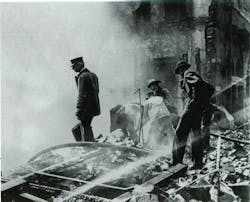LOS ANGELES, CA: OCT. 1, 1910 — At 1:07 A.M., a bomb exploded in the alley behind the Los Angeles Times building at First Street and Broadway. It was just before presstime and the building was filled with 115 men and women putting the final touches on the next edition of the paper. Sixteen sticks of dynamite detonated, causing the south wall facing Broadway to collapse. The second floor then collapsed under the weight of its printing presses onto the first floor. The first floor then collapsed into the basement, destroying the heating plant and gas mains. Flames quickly engulfed the three-story stone landmark. The few windows not filled with fire were full of people calling for help as the first Los Angeles Fire Department units rolled in and a frantic rescue effort began. Second and third alarms were transmitted immediately, bringing eight engines, two ladders, a combination chemical and hose wagon, and the water tower to the scene. A life net was deployed and several people jumped to safety. Hose streams were directed at the blazing structure as the rescue work continued. Firefighter William Campbell of Engine 17 was operating a line just inside the building when the second floor collapsed, burying him up to his neck in stones, beams and rubble. Under protective streams, firemen began the difficult and dangerous rescue of their brother. They dug for more than two hours until they cleared everything except an iron beam pinning his foot. The firemen could not cut the beam, so Campbell's foot was amputated by a doctor. But amazingly, after 3½ hours trapped under the rubble, Campbell was removed alive. The final toll was 21 workers killed and scores injured. The bombers were captured and convicted.
MARBLEHEAD, MA: OCT. 2, 1910 — Embers from a brushfire apparently were blown underneath the Marblehead Motorboat Co. plant, setting the building on fire. The entire old fishing village was threatened at one point as firemen battled the flames in the face of gale-force winds. Mutual aid responded from Lynn, Peabody, Salem and Swampscott. After two hours of hard work, the fire was finally under control at about 3 A.M., but not before the Unitarian Church, built in 1832, and a large home were destroyed.
NEW YORK CITY: OCT. 3, 1910 — While returning from a false alarm, FDNY units noticed glow in the sky and transmitted a second alarm on arrival as they were confronted with an advanced fire in the huge Moore Lumber Yards at 24th Street and Eleventh Avenue in Manhattan. Within minutes, the flames had jumped the avenue and set fire to Clark & Wilkins, said to be the largest kindling-wood establishment in the city. Soon, flames were shooting hundreds of feet into the sky over Manhattan and spreading with amazing speed. Third, fourth and fifth alarms were sent in as units from all over the borough and nearly the entire fireboat fleet descended on the blaze. For two difficult hours, firemen battled the fire and a stiff wind and finally subdued the flames. The loss was placed at $1.5 million.
JERSEY CITY, NJ: OCT. 3, 1910 — As thousands of people watched the huge fire across the North River in New York City, a major fire was blazing in the Greenville Coal & Ice Co. on Princeton Street. Flames quickly spread to the building next door, the NY Revolving Portable Elevator Co. plant. A second alarm was transmitted on arrival and moments later a general alarm was sounded. Flames and smoke shot across the Central Railroad tracks, disrupting service until the wind changed direction. The coal and ice plant was composed of a two- and three-story frame and brick buildings and a 60-foot-high icehouse. The elevator plant was a three-story brick building. Several firemen battling the blaze were overcome by smoke.
MONTREAL, QUEBEC: OCT 13, 1910 — Five people were known dead and two others were missing after flames tore through the King's Hall building on St. Catherine Street, West. The dead included the night watchman, his wife and their two children. It was believed everyone had escaped the fire until relatives of one of the missing men arrived after the fire was under control. A thorough secondary search of the charred remains located the fatalities.
PAUL HASHAGEN, a Firehouse® contributing editor, is a retired FDNY firefighter who was assigned to Rescue 1 in Manhattan. He is also an ex-chief of the Freeport, NY, Fire Department. Hashagen is the author of FDNY: The Bravest, An Illustrated History 1865–2002, the official history of the New York City Fire Department, and other fire service books. His latest novel, Fire of God, is available at dmcfirebooks.com
About the Author
Paul Hashagen
PAUL HASHAGEN, a Firehouse® contributing editor, is a retired FDNY firefighter who was assigned to Rescue 1 in Manhattan. He is also an ex-chief of the Freeport, NY, Fire Department. Hashagen is the author of FDNY: The Bravest, An Illustrated History 1865-2002, the official history of the New York City Fire Department, and other fire service books.
Connect with Paul
Website: paulhashagen.com
Facebook: Paul Hashagen-author
